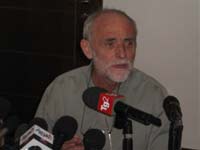Middle East - report
Respect international law and let us work, says Red Cross chief
by Tony Cross
Article published on the 2009-01-14 Latest update 2009-01-14 14:29 TU
Press conference: Jakob Kellenberger,President of the International Red Cross and Red Crescent
Speaking in Jerusalem on Wednesday, Kellenberger said that an “increased number of women and children” have been brought into Gaza’s Shifah hospital.
Pointing out that Gaza has 75,000 people per square kilometre, compared to 25,000 per square kilometre in Manhattan, he said that such a dense population means that “the choice of weapons is important”.
Kellenberger said that he had seen no evidence of the Israelis using white phosphorous on his visit to the hospital. The chemical, which can inflict serious injuries on victims, is banned for use as a weapon, although not when used for cover for military operations. Newspaper reports have alleged that it is being used in the Gaza offensive.
Life in the southern Israeli town of Sderot, which has been the target of hundreds of Palestinian rocket attacks, is “very difficult for civilians”, Kellenberger said, adding that “for children the experience can be very traumatic”.
Military operations prevent ICRC workers helping civilians, said Katharina Ritz, who manages the NGO’s Gaza operation.
She knew of one case of an ambulance being stopped by soldiers but many more of aid workers being unable to help civilians because of roadblocks and other military activity. The three-hour humanitarian truce is sometimes violated, she said.
Kellenberger called for aid workers to be allowed to do their work, in accordance with international law. The three-hour humanitarian truce should be extended, he added.
“There are many, many dead people in houses in the areas and this is quite a concern for the public hygiene,” says Ariz.







